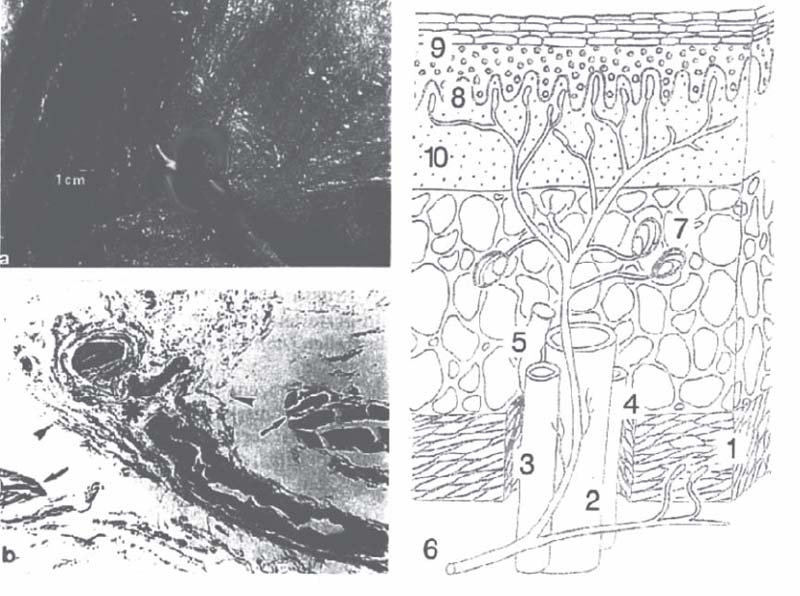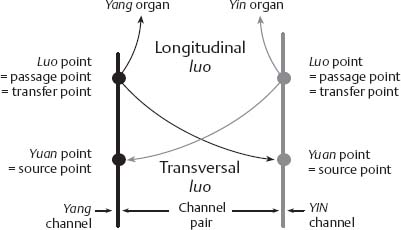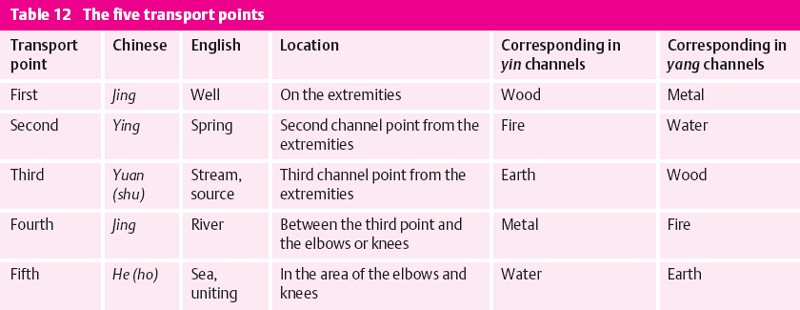2 | Systematics |
“Access To The Depth”—Xue: The Point
 Acupuncture Points
Acupuncture Points
The Western term “point” is called xue in China. This translates as “access,” “opening,” “hole,” or “cave,” which describes the access from the surface of the body to deeper structures. The acupuncture point is viewed as a point of access to the intricate channel system that connects the surface of the body with the internal organs. According to Traditional Chinese Medicine (TCM), acupuncture points are locations on the body that allow the correction of the imbalanced flow of qi. This restores the harmonious balance of the forces that affect the patient’s organism.

Fig. 9 Acupuncture point feng shi (GB-31) on the lateral thigh, above the knee joint
(a) Macroscopic preparation. Fascia lata with perforating neurovascular bundle (arrow)
(b) Histological cut through the sharply-defined area of perforation (arrows) with neurovascular bundle, embedded in interstitial connective tissue. X10
(c) Model of an acupuncture point. The superficial fascia (1) is perforated by a neurovascular bundle (2–6) in the area of the acupuncture point. 2 and 3 = veins, 4 = arteries, 5 = lymph vessels, 6 = nerve, 7 = Pacinian corpuscle, 8 = Meissner corpuscle, 9 = epidermis, 10 = subepithelial tissue. The mesenchymal sheath of the neurovascular bundle is not depicted
Acupuncture points can be verified bioelectrically (by virtue of measuring electrodermal activity) and on the tissue level.
The classical acupuncture points were examined in regard to their anatomical, histological, electrophysiological, neurophysiological, and humoral properties. Back in the 1960s, the professor of anatomy Keller (University of Vienna) analyzed 10000 histological serial sections and discovered that an acupuncture point contains 0.31 receptors (Meissner, Krause, and Golgi-Mazzoni corpuscles) per mm2 of skin preparation. Outside of the defined area of a point, 0.16 receptors per mm2 were found. In 1987 the professor of anatomy and physiology H. Heine explained the function of the superficial fascia in regard to the acupuncture point. He found that in more than 80% of the classic acupuncture points the fascia is perforated by a neurovascular bundle of 3–9 mm thickness. In the area of perforation, the nerves are enveloped by at least two concentrically placed, thin-walled collagen cylinders that are filled with loose connective tissue. Electrophysiological research showed that when exposed to AC and DC current, acupuncture points are less resistant than “regular” areas of the skin. The increased conductivity at the acupuncture point is based on the high H2O content of the mesenchymal sheath enveloping the perforating neurovascular bundle. Due to the rigid environment of its perforation location, the neurovascular bundle at the acupuncture point cannot give way to changes in pressure, volume, pull, and flow. Thus, in case of local, segmental, unilateral, or symmetrical regulatory disorders, the accompanying axons and the sympathetic vagomotor plexus in the artery walls are stimulated.
The acupuncture points constitute a window into the so-called basic regulating system. If an acupuncture point is continuously stimulated by nonphysiological means, superior neural centers are activated. The organism reacts by releasing pain peptides. While pain increases at the corresponding acupuncture points, the reflex arc intensifies. Acupuncture therapy enhances the central pain inhibition, which breaks the vicious circle of this chain reaction. According to research, acupuncture is able to counteract the imbalanced sympathetic nervous system and thus eliminate the potential risk of organ damage.
Of particular importance is the way that acupuncture points communicate among each other by way of the axonal reflex. The structure of the superficial fascia in relation to kinetically connected muscle groups seems to be most important to the order of the acupuncture points along the channels.
The de qui sensation (needle sensation, obtaining qi) can be induced at numerous acupuncture points. Thus, it is possible to regulate the disrupted flow of energy with corresponding manipulation techniques, using needles or moxa, at any acupuncture point. In addition, every acupuncture point is associated with a particular therapeutic purpose that has to be considered when choosing points. TCM acknowledges 13 categories of specific points and their effects that have been passed on through traditional teachings.
Of the 700 acupuncture points listed, 361 are located along the channels and the remaining ones are located away from the channels. It is a characteristic of the channel points that in case of a disease, several points on the same channel show changes in their reactivity. Points located away from the channels display changes individually or in separate groups. Also, when inserting the needle into a channel point, the typical needle sensation travels along the corresponding channel.
Characteristic for all acupuncture points is the detectable change (pressure and tactile sensation) in the tissue underneath, as a reaction to disease processes in remote parts of the body. These changes in reactivity patterns can be palpated as tissue changes in form of nodules, or the patient perceives changes as an altered pressure and touch sensation when the point is stimulated. Electronic point locators that are available on the market can also be used to identify acupuncture points. The locators work by detecting changes in skin resistance at the acupuncture points.
 Channel Points
Channel Points
Connected like a string of pearls, 361 channel points are located along the 12 main channels and the two extraordinary vessels du mai and ren mai. The affiliation of a point with a particular channel gives a possible basic indication of the channel, organ, and five phase theory. In each channel point four effects can be distinguished:
1. A local, regional, and segmental effect with a topographic relation to the seat of the disease (distant points, local points, points on the affected channel or network vessel)
2. A channel-related functional effect (relating to the channel system, the energy of the body)
3. An organ-related effect
4. A point-specific symptomatic effect (symptomatic points).
Four Main Categories
The acupuncture points can be roughly divided into four main and several subcategories. Because this categorization can vary from author to author, some points can be found in multiple lists.
Alarm (mu) points (mu = “collecting”; Table 8) are exclusively located in the area of the abdomen. In the case of diseases of organs or organ systems, they become very sensitive to pressure and touch, hence the term alarm points. Alarm points can be located on their own channel, on the channel of another organ network, or on the ren mai channel. They are important for diagnosing disorders of the hollow organs. When treating organ disorders, primarily those involving the hollow organs, they are used in combination with the lower he point (see p. 28) All alarm points are located at the front of the torso (mu front points). There is a particular reason why many alarm points are located on the ren mai channel: Many branches of the intercostal nerves from both sides of the thorax meet on the frontal channels—thus, the points on the ren mai channel get information from the inside of the body and can act on both sides of the body.
Table 8 Alarm (mu) points
Organ | Acupuncture point |
|---|---|
Heart | CV-14 |
Small intestine | CV-4 |
Bladder | CV-3 |
Kidney | GB-25 |
Pericardium | CV-17 |
Triple burner | CV-5 |
Gallbladder | GB-24 |
Liver | LR-14 |
Lung | LU-1 |
Large intestine | ST-25 |
Stomach | CV-12 |
Spleen | LR-13 |
Associated shu points (Table 9): All of the associated shu points are located on the back on the inner (first) branch of the bladder channel, 1.5 cun lateral to the median (du mai channel), on top of the costovertebral joints. According to the traditional concept, they move the life force qi to the corresponding organs. Each of the six yin, or full organs, and each of the six yang, or hollow organs, is related to one associated shu point on the bladder channel. Associated shu points are indicated in the case of organ disorders because they directly affect the organ networks on a segmental level. They are important for diagnosis because they become sensitive to pressure when the corresponding organ is diseased.
• Moxibustion is frequently (in the case of vacuity disorders) applied at associated shu points.
• Therapy at associated shu points is of special importance in the case of chronic diseases. TCM recommends treatment of the associated shu points combined with the corresponding source point in the case of organ disorders.
Points relating to organs
• Source points (yuan points)
• Network points (luo points)
Source and network points (Table 10, Fig. 10) are part of the classic acupuncture points. They are located at the wrists and ankles. Source and network points of coupled channels are connected. Source and network points primarily intensify the effects of the needle treatment on other points. They are also used in the case of disturbances along the pathway of a channel. Here, tonifying techniques are applied at the source point of the disturbed channel and the network point of the coupled channel.
Table 9 Associated (shu) points
Organ | Acupuncture points |
|---|---|
Heart | BL-15 |
Small intestine | BL-27 |
Bladder | BL-28 |
Kidney | BL-23 |
Pericardium | BL-14 |
Triple burner | BL-22 |
Gallbladder | BL-19 |
Liver | BL-18 |
Lung | BL-13 |
Large intestine | BL-25 |
Stomach | BL-21 |
Spleen | BL-20 |
Conception vessel (ren mai) 4 | BL-26 |
Conception vessel (ren mai) 6 | BL-24 |

Fig. 10 Luo connection (according to Kampik)
Table 10 Source (yuan) and network (luo) points
Source point (yuan) | Network point of the coupled channels (luo) |
|---|---|
HT-7 | SI-7 |
SI-4 | HT-5 |
BL-64 | KI-4 |
KI-3 | BL-58 |
PC-7 | TB-5 |
TB-4 | PC-6 |
GB-40 | LV-5 |
LR-3 | GB-37 |
LU-9 | LI-6 |
LI-4 | LU-7 |
ST-42 | SP-4 |
SP-3 | ST-40 |
It is the function of the network (luo) point (luo = connect) to transfer excess channel energy to the connecting channels that provide connections to the coupled channel (a channel pair is always made of one yin and one yang channel) and thus assist in balancing energy.
The Five Transport Points
TCM’s concept of an energy flow that moves proximally starting at the extremities stems from the period before the channel system was used. The energy flow (qi) is compared with a river. The path of a stream from its well to the ocean is the metaphor for the growth pattern.
The energy originates at the well, first transport point (jing point; jing = well). All of the 11 jing points are located at the corner of the nail beds of the fingers or the toes (except the jing point of the kidney channel, which is located at the sole of the foot).
Tip
Today, the use of the jing points is limited to acute disorders. HT-9 is one of the most important acute or emergency points for disturbances of the circulatory system, and BL-67 is significant as a tonifying point for the bladder channel and in connection with obstetric indications. PC-9 is used to regulate circulatory problems, and LU-11 is used for a sore throat, for example. The remaining well transport points are of rather little importance in daily practice.
The water originating in the well turns into a spring. This is why the second transport point is called spring (ying) point. According to the traditional concept, the energy of a channel can be activated and accelerated from the spring transport points. The spring points are insignificant in daily practice.
The third transport point is the “stream point” (yuan point). The yuan point is also called source point. It is located at the wrist or the midfoot. The source point is the collection point for qi that is sent to the coupled channel and serves as the energy balance.
The jing point (“river point”) is the fourth transport point. It is located near or proximal to the wrist or ankle. The most important river points are SP-5, BL-60, and KI-7.
At the fifth transport point (he = sea or “uniting,” which indicates that the river of qi unites with the sea of the body; Table 11), the superficial, distal pathway of the channel turns into the deeper, proximal part. In this way, the he point connects the peripheral with the proximal pathway of the channel. The use of he points is indicated when treating diseases of the internal organs (particularly chronic disorders). They are all located near the elbows and knees. Channels that run along the upper extremities have an additional he point at the knees.
Table 11 He (ho) points
Organ | He point | Lower he point |
|---|---|---|
Heart | HT-3 | – |
Small intestine | SI-8 | ST-39 |
Bladder | BL-40 (BL-54 Bi) | – |
Kidney | KI-10 | – |
Pericardium | PC-3 | – |
Triple burner | TB-10 | BL-39 (BL-53 Bi) |
Gallbladder | GB-34 | – |
Liver | LR-8 | – |
Lung | LU-5 | – |
Large intestine | LI-11 | ST-37 |
Stomach | ST-36 | – |
Spleen | SP-9 | – |
Each of the five stations—well, spring, stream, river, and sea (uniting)—corresponds to one transport point. Thus, every regular channel has five transport points. There are 60 transport points in total, (Tables 12, 13) from which the traditional tonifying and sedating points originate.

Stay updated, free articles. Join our Telegram channel

Full access? Get Clinical Tree


